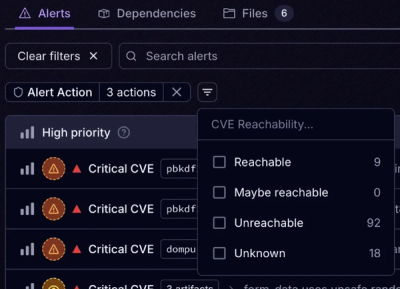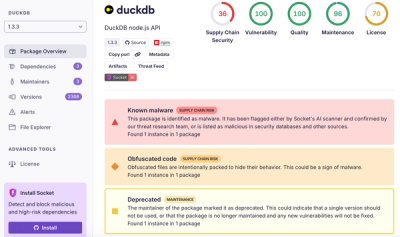
Product
Introducing Tier 1 Reachability: Precision CVE Triage for Enterprise Teams
Socket’s new Tier 1 Reachability filters out up to 80% of irrelevant CVEs, so security teams can focus on the vulnerabilities that matter.
A client-side API abstraction layer.
Gangway is our general purpose tool for working with APIs on the
client-side. It is a thin layer on top of superagent with specific
opinions related to how we work.
Gangway is a factory function that progressively layers configuration
options for building an AJAX request with superagent.
The returned value of all endpoints follow the Promise
interface. Invocations of that interface return real Promises. This
means you'll need to include your own polyfill for Promise (depending
on your environment). We recommend
then/promise as it includes
additional methods like .done() and .nodeify() that improve
interoperability and debugging:
require('promise/polyfill')
// Continue with the rest of your code
Alternatively, provide Promise as a configuration option (see below):
var Gangway = require('gangway')
var API = Gangway({
baseURL: 'http://example.com',
headers: {
'x-api-key': 'your-token-for-every-request'
},
Promise: require('promise') // Optional, if Promise is not polyfilled
})
API.route({
getUser: {
method : 'GET',
path : '/users/{id?}' // ? indicates that the parameter is optional
}
}
})
API.getUser() will now perform a GET request to
/users/{id}. The ? in the path option specifies that it is
optional. This is useful when using the same route for index and show
endpoints for resources.
Most APIs break down endpoints into discrete resources. Gangway
provides a namespace method for this purpose. All routes will be
prefixed with a provided URL segment:
API.namespace('users').route({
read: {
method : 'GET',
path : '{id?}' // ? indicates that the parameter is optional
}
}
})
API.users.read({ params: { id: 2 }}) will perform a GET request to /users/2.
.resourceFor RESTful resources, adding routes this way can become tedious. Gangway provides another method for quickly building routes for RESTful resources:
// This is equivalent to creating a create, read, update, and destroy
// route. Options are folded into every route.
API.resource("comments", {})
Assuming the previous steps have been followed, Gangway is ready for use!
// This will send a request to GET http://example.com/users
API.users.read()
// This will send a request to GET http://example.com/users/10
API.users.read({ params: { id: '10' } })
// The same is true for routes added via API.resource
API.comments.read({ params: { id: '2' }})
It is some times useful to access the unwrapped superagent request
object. The value returned from endpoints contains a request
property that grants access to this instance:
let fetch = API.users.read({ params: { id: '10' } })
fetch.request.abort()
Checkout the ./docs folder and the available options below. Or consider working through the Hello Gangway guide.
baseURL : The base URL prepended to all requests
body : The request body
headers : Request headers,
method : Request method (GET, POST, PUT, PATCH, DELETE, etc...)
beforeSend : Configure an instance of superagent before the request is sent
onResponse : Run before resolving a request to preprocessing data
onError : Run before rejecting a request to preprocessing errors
buildQuery : Run before a query string stringifies.
params : Populate bindings in paths and are sent as request bodies. Defaults to body.
Promise : The Promise implementation. Defaults to global.Promise.
path : The path fragment of the endpoint, appended to baseURL
type : Content type, defaults to JSON
query : An object of query parameters. Gangway will automatically stringify this into the URL.
timeout : Request timeout in milliseconds. Defaults to 15 seconds.
Gangway wraps around superagent, leaning on it to build a response object. This object is documented within superagent, however the important parts are:
{
"text": "...", // The unparsed response body string
"body": {}, // The parsed response body
"status": 200 // The HTTP status code for the request
}

Visit code.viget.com to see more projects from Viget.
2.2.0
FAQs
A client-side API abstraction layer
The npm package gangway receives a total of 5 weekly downloads. As such, gangway popularity was classified as not popular.
We found that gangway demonstrated a not healthy version release cadence and project activity because the last version was released a year ago. It has 2 open source maintainers collaborating on the project.
Did you know?

Socket for GitHub automatically highlights issues in each pull request and monitors the health of all your open source dependencies. Discover the contents of your packages and block harmful activity before you install or update your dependencies.

Product
Socket’s new Tier 1 Reachability filters out up to 80% of irrelevant CVEs, so security teams can focus on the vulnerabilities that matter.

Research
/Security News
Ongoing npm supply chain attack spreads to DuckDB: multiple packages compromised with the same wallet-drainer malware.

Security News
The MCP Steering Committee has launched the official MCP Registry in preview, a central hub for discovering and publishing MCP servers.